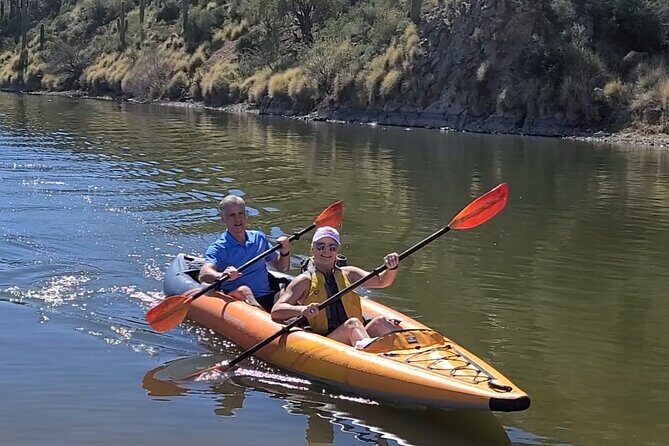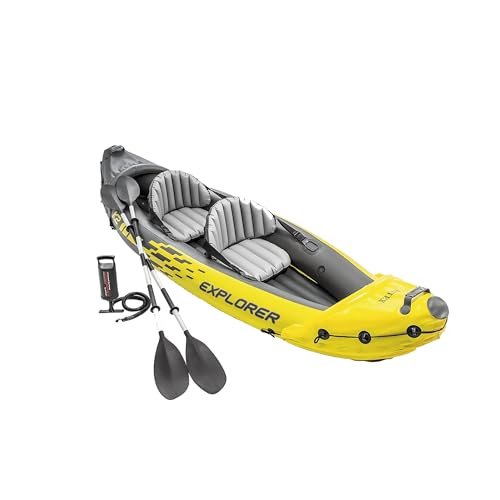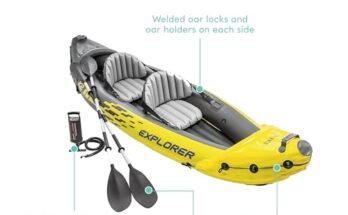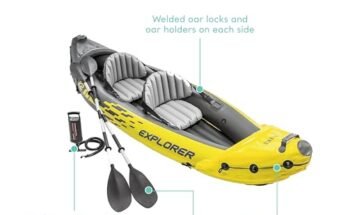Ready to share an unforgettable adventure on the water? Kayaking with two people is not just fun—it’s a perfect way to connect, explore, and enjoy nature together.
But how do you make sure you both paddle in sync, stay balanced, and have the best experience possible? This guide will give you simple, clear steps to master kayaking for two. By the end, you’ll feel confident, coordinated, and eager to hit the water with your partner.
Keep reading, and get ready to turn your next trip into an exciting, smooth ride!
Choosing The Right Tandem Kayak
Kayaking with two people is fun and a great way to explore water together. Picking the right tandem kayak is important for a good trip.
This guide helps you find the best kayak for two, so you enjoy safety and comfort on the water.
Types Of Tandem Kayaks
Tandem kayaks come in different shapes and styles. Each type suits different water and paddling needs.
Choose the one that matches where and how you want to kayak.
- Recreational Kayaks:Good for calm lakes and slow rivers. They are wide and stable.
- Touring Kayaks:Made for longer trips. They are faster and easier to paddle over distance.
- Inflatable Kayaks:Easy to carry and store. Ideal if you have little space.
- Whitewater Kayaks:Built for rough waters. They are strong and very maneuverable.
Size And Weight Considerations
Size and weight affect how easy it is to carry and paddle your kayak. Think about who will handle the kayak.
Make sure it fits your storage space and the water you will use it in.
- Longer kayaks are faster but harder to turn.
- Wider kayaks offer more stability but slower speed.
- Lighter kayaks are easier to carry and launch.
- Check the kayak’s weight capacity to hold two people and gear.
Essential Features To Look For
Look for features that add comfort, safety, and ease of use for two paddlers.
- Adjustable Seats:Help both paddlers sit comfortably for long trips.
- Footrests:Provide better control and paddling power.
- Storage Space:Keep your gear dry and safe during the trip.
- Handles:Make carrying the kayak easier.
- Skeg or Rudder:Helps with steering and tracking in windy or rough conditions.
Gear And Safety Equipment
Kayaking with two people needs careful planning and the right gear. Safety equipment keeps you secure on the water.
Choosing the right gear helps you enjoy your trip and handle emergencies well.
Life Jackets And Personal Flotation Devices
Each person must wear a life jacket or personal flotation device (PFD) while kayaking. Choose PFDs that fit well and are comfortable.
Look for PFDs designed for kayaking. They should allow easy paddling and quick movement.
Paddles For Two
Two-person kayaks need paddles that are easy to use by both paddlers. Usually, each person uses one paddle.
| Type | Description | Best Use |
| Standard Double-Blade | Two blades, lightweight | Most common for tandem kayaking |
| Adjustable Length | Can change paddle length | Good for different paddler sizes |
| Carbon Fiber | Strong and light | For longer trips and better control |
Safety Accessories And Communication Tools
- Whistle or signal horn to call for help
- Waterproof flashlight or headlamp for low light
- Mobile phone in a waterproof case
- VHF marine radio for areas with coverage
- First aid kit with basic supplies
Make sure all safety accessories are easy to reach. Test communication tools before you start your trip.
Positioning And Seating
Kayaking with two people needs good seating and positioning. Comfort and balance keep the kayak steady.
Each paddler has a role based on where they sit. Proper weight spread helps the kayak move well.
Front Vs. Back Seat Roles
The person in front sets the paddling pace and rhythm. They steer with regular strokes and guide direction.
The back paddler helps steer and controls speed. They adjust power to keep the kayak balanced and on course.
- Front seat: sets pace, leads navigation
- Back seat: steers and controls speed
- Both must communicate for smooth paddling
Adjusting Seats For Comfort
Seats should be adjusted to fit each paddler’s size. Proper seat height and backrest angle reduce strain.
Use seat padding if the kayak feels hard. Keep knees slightly bent and feet resting comfortably on footrests.
- Adjust seat forward or backward for leg comfort
- Set backrest to support your lower back
- Add cushions for extra padding if needed
- Keep feet flat on footrests for stability
Weight Distribution Tips
Even weight spread helps keep the kayak stable and fast. Heavy gear should be placed near the center.
The front and back paddlers should weigh about the same. If one is heavier, adjust seat position to balance the kayak.
- Place heavy items low and near the kayak center
- Balance paddlers’ weight front to back
- Shift seats slightly to compensate for weight differences
- Avoid too much weight in one area to prevent tipping

Basic Paddling Techniques
Paddling a two-person kayak needs teamwork and good skills. Both paddlers must work well together to move smoothly.
Learning basic paddling techniques helps you enjoy the water more. It makes your kayak faster and easier to control.
Synchronizing Strokes
Both paddlers should paddle at the same time. This keeps the kayak balanced and moves it straight.
Watch your partner’s strokes and match their rhythm. Use signals or count out loud to stay in sync.
- Start paddling together on the same side
- Keep the paddle angle the same for each stroke
- Adjust speed if your partner is faster or slower
Efficient Paddle Strokes
Use smooth, strong strokes to move the kayak well. Avoid quick, shallow strokes because they waste energy.
Enter the paddle blade fully into the water. Pull it back close to the kayak before lifting it out.
- Keep your arms straight but not stiff
- Use your torso to add power to each stroke
- Keep the paddle blade fully submerged during the stroke
Steering And Turning Together
Steering a two-person kayak needs both paddlers to work as one. One paddler can steer while the other helps with power.
For turns, the paddler in the back usually controls the direction. The front paddler supports with stronger strokes.
- To turn left, back paddler strokes backward on left side
- To turn right, back paddler strokes backward on right side
- Both paddlers can use forward strokes on the opposite side for sharper turns
Communication Between Paddlers
Kayaking with two people needs good communication. Talking helps both paddlers work as a team.
Clear signals and timing keep the kayak steady and safe. Both paddlers must listen to each other.
Establishing Signals
Before starting, decide on hand or paddle signals. These signals show direction changes or stops.
Simple signals avoid confusion and keep paddlers alert. Practice these signals on calm water first.
- Point paddle left or right to turn
- Raise paddle vertically to stop
- Wave hand to get attention
- Tap paddle on kayak to signal speed up
Maintaining Rhythm And Pace
Both paddlers should match their strokes. This keeps the kayak moving smoothly and straight.
One paddler can lead the rhythm. The other follows to keep pace steady and avoid tiring quickly.
- Count strokes aloud or silently together
- Keep strokes even in length and speed
- Adjust speed if water or wind changes
- Stop paddling together to rest
Handling Disagreements On Water
Disagreements can happen during kayaking. Stay calm and use clear words to solve problems.
Agree to stop paddling and talk if needed. Respect each other’s ideas and find a good solution.
- Pause paddling to discuss issues
- Listen carefully to each other
- Choose safe spots to stop and talk
- Keep focus on safety and fun
Advanced Tandem Maneuvers
Kayaking with two people requires coordination and teamwork. Advanced tandem maneuvers enhance your kayaking experience.
These skills help you navigate challenging waters and ensure safety. Let’s explore some techniques.
Navigating Rough Water
Rough water can be intimidating for tandem kayakers. Keep your kayak steady and balanced.
Use synchronized paddling to maintain control. Communicate constantly with your partner.
- Watch for waves and adjust your paddling speed
- Keep your weight centered to avoid tipping
- Use quick strokes to steer through obstacles
Executing Sharp Turns
Sharp turns require precise movements in tandem kayaking. Practice makes perfect when turning swiftly.
The front paddler initiates the turn. The rear paddler supports and completes the action.
- Lean into the turn for better control
- Front paddler pulls while the rear paddler pushes
- Communicate clearly to avoid confusion
Rescue Techniques For Two
Safety is crucial in kayaking. Knowing rescue techniques for two can save lives.
Practice these skills regularly with your partner. Stay calm and work together in emergencies.
- Use a paddle float for stability during re-entry
- One paddler stabilizes while the other re-enters
- Always wear a life jacket for safety
Practice Drills For Tandem Teams
Kaiaking with two people requires teamwork. Practice makes you better. Here are some drills for improving skills.
Focus on coordination, endurance, and emergency response to kayak safely and efficiently as a team.
Building Coordination Skills
Coordination is key in tandem kayaking. You need to paddle together. This makes the kayak move straight and fast.
Practice syncing your paddle strokes. Begin by counting out loud. This helps both paddlers stay in rhythm.
- Sit in the kayak on dry land first
- Count “1, 2, 3, paddle” together
- Start slowly, then increase speed
Improving Endurance Together
Endurance keeps you kayaking longer. Practice paddling for extended periods. This builds muscle and stamina.
Set small goals. Paddle for 10 minutes without stopping. Increase the time as your endurance grows.
- Paddle in calm waters first
- Take breaks as needed
- Gradually increase your paddling time
Emergency Response Drills
Emergencies can happen anytime. Practice drills to prepare. Know how to handle capsizing and other issues.
Stay calm in emergencies. Communicate clearly with your partner. This helps you respond quickly and effectively.
- Practice capsizing and recovery in shallow water
- Learn how to signal for help
- Understand basic first aid

Maintenance And Care For Tandem Kayaks
Taking care of your tandem kayak keeps it safe and ready for your next trip. Regular maintenance prevents damage and extends its life.
Focus on cleaning, storage, and inspecting your kayak often. Check all equipment to avoid problems on the water.
Cleaning And Storage Tips
Clean your kayak after every use. Remove dirt, salt, and debris to stop wear and tear. Dry it fully before storing to prevent mold.
- Use fresh water and mild soap for cleaning
- Rinse off saltwater carefully
- Dry all parts, including seats and compartments
- Store kayak in a cool, dry place away from sunlight
- Keep kayak off the ground using racks or padded supports
Inspecting For Wear And Damage
Look over your kayak regularly for cracks or holes. Check the hull, seats, and handles for signs of wear. Fix small damage early to avoid bigger problems.
| Part | What to Check | Signs of Damage |
| Hull | Surface and edges | Cracks, holes, deep scratches |
| Seats | Attachment points and fabric | Loose straps, tears, worn padding |
| Handles | Grip and mounts | Cracks, looseness, missing parts |
| Deck lines | Knots and cords | Fraying, breaks, weak spots |
Regular Equipment Checks
Check all your kayaking gear before each trip. This includes paddles, life vests, and safety items. Make sure everything works and is in good shape.
- Inspect paddle blades for cracks or chips
- Test life vests for proper fit and function
- Check spray skirts for tears or holes
- Examine safety gear like whistles and lights
- Replace any broken or worn items promptly

Frequently Asked Questions
What Equipment Is Needed For Two-person Kayaking?
You need a tandem kayak, two paddles, life jackets, and safety gear. Proper clothing and a dry bag are helpful. Ensure all equipment fits comfortably and is in good condition before kayaking.
How Do Two People Coordinate Paddling In A Kayak?
Communication is key. The front paddler sets the pace, and the rear paddler steers. Both should synchronize strokes and maintain a steady rhythm for efficient movement.
What Safety Tips Are Important For Kayaking With Two People?
Always wear life jackets, check weather conditions, and inform someone of your trip. Carry a whistle, first aid kit, and stay close to shore if you’re a beginner.
How To Properly Load And Balance A Two-person Kayak?
Distribute weight evenly between front and rear seats. Place heavier gear low and centered. Balanced loading improves stability and makes paddling easier for both kayakers.
Conclusion
Kayaking with two people can be a fun and safe activity. Communication and teamwork help keep the kayak steady. Always wear life jackets and check the weather before you go. Practice paddling together to move smoothly on the water. Start in calm areas and take your time learning.
Enjoy the peaceful moments and the beautiful views around you. With patience and care, kayaking can bring great memories for both paddlers. Keep these tips in mind for your next two-person kayak trip.



